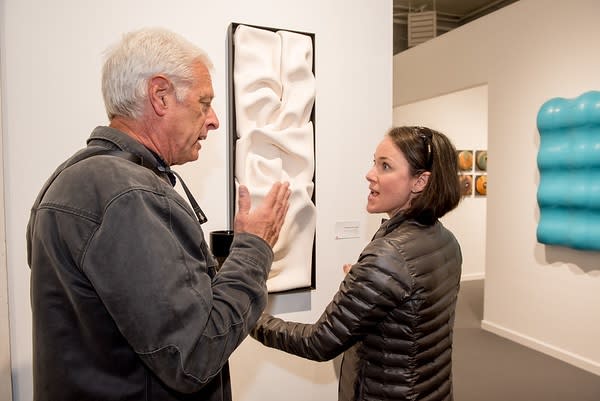
Today, we’re speaking with Steven Goldstein, architect, art consultant, and Asheville local. Steven will be sharing with us his professional insights on buying art for a home, what makes a great piece and how to put a collection together (and how not to!).
Momentum Gallery (MG): Steven, thanks for spending some time with us today. Please tell us, how did your career as an arts consultant come to be?
Steven Goldstein (SG): That’s no problem, pleasure to be talking with you today. So, to answer your question, I used to run an architectural practice, specializing in private homes and high-end residential properties.
After successfully completing these projects, my clients started to ask me to work on other types of buildings, such as their offices, medical buildings, hotels etc.
Since 1969, I’d started to build my own art collection, and so when my clients came to visit my home office, they saw this for themselves, and understood how it related to the space which housed it. If they were new to collecting art, or their own collections perhaps were not so well thought-out, they would, from time to time, ask me to assist in putting together a collection for them. I’d worked with some of these clients for more than 20 years, so we already had a good working relationship and understanding.
MG: That’s fantastic; an interesting career switch to make. So in terms of helping your clients to choose a piece, as we all know, art is so subjective... from a collector’s point of view, should you simply buy the art you love or are there any ‘rules’ to follow?
SG: It really depends on whether or not you are new to the game. If you are experienced, then buying what you love and only what you love is probably the right advice. If you are inexperienced, buying what you love could land you with a whole lot of stuff you think is ordinary or weak later on.
When I start working with a client, I recommend they visit lots of different galleries to experience the differences. Some galleries are only interested in what sells; they’re more commercial and the work can be overpriced. When you dig deeper, you realize it's actually quite ordinary. Once the client has seen these variations, they should be starting to get an understanding of what are they drawn to. Non-representational work being a good example - if a client really doesn’t like that genre, there is no point in sending them to a gallery that specializes in that type of art. Then we move on to exploring what is good in the genres they like.
When we get to the point where there is an artist whose work stands out to them, I then like to teach the client to delve into the artist’s background. Knowing where they were trained for example, will help them understand and see the characteristics of that particular school coming through the work. We look at what this artist has done across their whole career, which with a mid-career artist would be a 10-15 year period. Only at that point will you understand who that artist truly is, and the nature of their work, and then you are equipped to pick the best piece for you.

Steven Goldstein speaking with artist Jeannine Marchand in front of her work
MG: Thank you. So in terms of the purchase, should collectors have a space in mind or a predetermined idea of where it will live?
SG: It’s fine to have a spot for which you are looking. Sooner or later, though, most collectors end up buying pieces they don't want to live without and find a place to put them.
MG: Time to buy a bigger house, I guess! Steven, in your opinion, is it better to buy a bigger piece by a lesser-known artist or go for a smaller piece by a tried and tested ‘name?’
SG: Budget is important, although the second part of this question has little to do with the first. I advise people to know how much they are comfortable spending at any given time. The balance between bigger unknowns and smaller knowns makes no sense to me at all. If the process required for an unknown artist to produce a small piece is complex or costly, it may cost more than a large one by another unknown or even someone known.
And you know, this is where a gallery owner becomes a really important part of your life. They will help you not to buy purely on a visceral response ,but help you find what’s going to be magic in your life from an aesthetic point of view.
Clients get a sense and feeling about whether the owner is just pushing to sell a piece. When I work with Jordan for example, I know he’s not pushing. He shares lots of information, clients can ask his opinion, learn more about the process - how a piece was made, and what went into it.
Above all, I think art should not be looked at as purely an investment. Instead, see it as a joy - that’s the motivating factor. Of course, if you’re one of the very few people in the world who are spending a minimum of six figures on a piece, then you probably shouldn’t be doing that unassisted. A good art consultant will be adept in knowing what’s happening in the market and current values.
MG: How does one know if the art ‘goes’ in the room - should the piece blend, or stand out?
SG: I never recommend trying to tailor art selections to the decor of a room. Most of my collectors end up with eclectic collections. The important thing is that pieces be displayed in a manner where they aren't competing. For example, I discourage loading a space with very colorful pieces. It is good to flank something with lots of color with muted or monochromatic pieces. Contrast is critical to even noticing the art.

Hoss Haley, Large Tessellation (Cyan), steel, automotive paint, 48 x 43-1/2 x 5-1/2 inches
One other thing that’s important to try to do is don’t leave pieces hanging in the same spot forever. That just breeds familiarity! You get so accustomed to seeing a piece you don’t actually ‘see’ it any more. Small and medium pieces can be rotated and moved so that visually, they look fresh again.
MG: Great tip! Similarly, in terms of the colour palette of the room - match or contrast?
SG: Contrast as a rule, but there are no rules.
MG: Proportion is everything in interior design. What advice can you give in terms of sizing/hanging?
SG: Hanging art on a wall requires analysis of a couple of qualities. The critical one is the amount of detail in the piece and the distance from which it must be seen to be appreciated. This is tougher with smaller highly-rendered/detailed pieces. You need to be close to really appreciate them so they may be in hallways, small rooms where you are circulating around the perimeter, and in bathrooms. If so, I advise finding the central focus of the piece and placing that center at eye level for the average adult viewer. Since people's heights vary a lot, this usually means around 5'3- 5'6 above floor level. If you have clients who are really tall or really short, you have to vary that so they can enjoy the works since they are the ones who will be viewing them every day. I find the biggest mistakes are in mounting height.
MG: What lighting considerations should be made?
SG: This is hard. Most homes are ill-suited to art display in terms of lighting. Most art is best seen with very pointed specific light coming from over the shoulder of the viewer, but certainly out of his/her viewline. Large pieces may require more than one light source and/or accenting certain areas of the piece. Employ outside interior design talent to help you with this.
MG: Finally, any tips for housekeeping (how to protect your art)?
SG: Invest in feather dusters and compressed air containers that don't spray any oil or liquid with the air. Be sure that any piece that is under Museum Glass is cleaned only with products that won't streak or harm the surface. Usually cleaners made for fragile computer screens will work on Museum Glass. Oddly enough, oil paints and acrylics are the most forgiving, but they still should be treated with some delicacy.
I also urge everyone who collects fine art to insure it. Collectors do not buy work to have it sitting in a vault. We like to see it and let our friends experience it as well. A good art policy, in addition to your homeowners insurance makes it easy to live with one’s art and not worry every time you serve someone a glass of red wine.
MG: Steven, thank you very much for your expert advice and insights! As you know, Jordan, Momentum Gallery’s owner has enjoyed spending time with you over the years as a client, art consultant, and friend.
Should you wish any additional information about Steven Goldstein and the services he provides, please feel free to contact him through Momentum Gallery at email@momentumgallery.com or 828-505-8550.